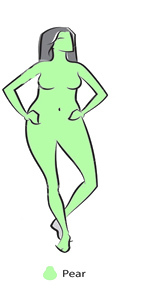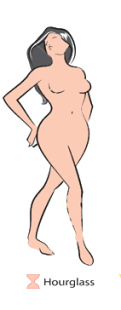Health by Shape: What Your Shape Means for Your Health
CHIROPRACTOR ERIC BERG, AUTHOR OF THE 7 PRINCIPLES OF FAT BURNING, EXPLAINS HIS HORMONE-DRIVEN BODY TYPES. WE RELATE THEM BACK TO OUR SHAPES!
The Adrenal Shape (Apple)
What it is: Our adrenal glands sit on the kidneys and deal with stress. “When too much stress builds up, your fight-or-flight response kicks in, triggering the hormone cortisol to build up fat around your most vital organs—which are located in your midsection,” Berg says.
What it means: Constant stress leads to poor sleep patterns, causing worry, excessive thinking, brain fog, poor memory, and weight gain, he says. “Most growth hormone is released at night, and this hormone regulates fat burn,” Berg explains. Trying to lose weight can actually cause you to add pounds since conventional diet programs that call for drastically cutting calories and overtraining with exhaustive workouts only further stress your body. “This is why hundreds of sit-ups every day will never give someone with the adrenal shape that flat stomach they desire,” Berg says. Overtime, as adrenal fatigue continues, tolerance to stress dives even lower and patience with others wears thing. “These types tend to be edgy and irritable, and oftentimes, others get on their nerves.”
The Thyroid Shape (Brick)
What it is: Your thyroid resides in the front of your lower neck and is about 2 and a half inches wide. It makes hormones that control the metabolism in all your cells. “Hence, thyroid types tend to get big all over, not in just one place,” explains Berg. “Many thyroid body types are triggered by the hormone estrogen. As estrogen becomes dominant, your thyroid slows down and over time, can become sluggish.” Stubborn baby weight that doesn’t seem to go away after giving birth is often due to a spike in estrogen, coupled with thyroid malfunction, he says.
What it means: Besides weight struggles, those with a thyroid body type also often suffer hair loss, saggy skin under the arms, ridged nails, and loss of the outer eyebrows, Berg says. “Thyroid types also tend to reach for simple carbs, such as bread, for quick energy to rev their sluggish metabolism.” You can get tested for thyroid disorders, but Berg says that problems don’t always show up on blood tests until the person is already in an advanced state.
The Ovary Shape
What it is: For women in childbearing years who are trying to conceive, having over-productive ovaries isn’t necessarily a bad thing. But for others, it can lead to saddlebags and lower stomach pooch, Berg says. Like the thyroid shape, too much estrogen triggers the ovary shape; in fact, people can be both shapes in their lifetime. “Many ovary body types turn into thyroid types after pregnancy due to the spike in estrogen, especially if the woman develops a thyroid problem during or shortly after having the baby,” he explains.
What it means: Ovary types can also suffer heavy periods and develop facial hair and acne, especially during that time of the month, Berg says. “Anything that is cyclic, such as headaches, PMS, bloating, and depression, can occur frequently with the ovary type, oftentimes during ovulation or about one week before a menstruation.”
The Liver Type
What it is: Your liver is a 3-pound organ under your right rib cage that filters toxins and helps digest your food. “Liver types typically have thin legs and a protruding belly,” explains Berg. “These types have a condition called ascites, which is essentially the liver leaking a plasma-like fluid into the sac that sits just above our intestines.” Because the liver type has this belly pooch, people often equate them to having a fat stomach, but in reality, they actually have lowbody fat. “Even if the person is 300 pounds, if most that weight in their tummy, a lot of it could be fluid. People always incorrectly assume that all weight is equated to fat, when it isn’t,” says Berg.
What it means: In healthy individuals, blood sugar naturally rises in the morning due to hormonal changes, but after fasting overnight, liver types inevitably wake up with low blood sugar—and irritability, Berg says. They also have digestive problems such as gas and heartburn after they eat because of their sluggish digestive juices. “This means food is not broken down thoroughly, and if bile isn’t released, the person will feel unsatisfied and crave quick carb energy,” Berg says.





